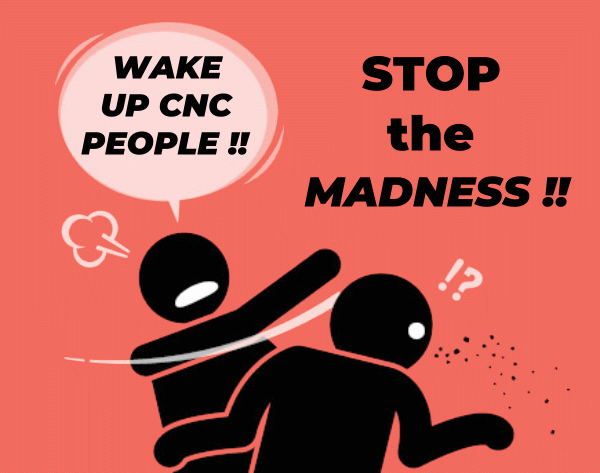Programming for Multiple Fixtures
So the decision has been made … “We need production … which means we need to mount as many vises or fixtures on the table as we can fit … to make as many parts as possible.”
First scenario …
- We are going to make all the same part.
- For our example here … let’s say that we can fit 4 fixtures on the table … we are going to machine 4 parts in one cycle.
Some thoughts :
- When the tool is in the spindle … we want to do as much work with it as possible. That means hitting each part on each fixture while it’s in the spindle.
- As mentioned in Part #1 … each fixture is independent with it’s own work coordinate system.
- As a set-up … we want to make one part first … confirm that it is correct dimensionally and that the cutting conditions are optimal … and then expand those toolpaths to machine the other vises.
- For this article … we are not going to be concerned with the actual G code program … more with the flow of the program. How we can structure the program to machine all the parts.
So we mount the fixtures on the table … set up and record our Work Coordinate Offsets … G54 – G57.
How can we write the program to machine one part … then expand it to 3 more parts … with the least amount of effort. Our suggestion : Sub Programming ( for a more in-depth MAKING CHIPS blog post on sub-programming … go here http://kentechinc.biz/the-hows-and-whys-of-cnc-sub-programming/
Here is the structure of our initial set-up program :
O0001 ( Main Program )
N0001
G00G91G28Z0
T01M06
G90S3500M03
G43Z1.500H01M08 ——– Put the tool in the spindle, start the spindle, position Z to clearance
G00G54X0Y0 ————— Move to the first fixture, call the sub to do the work with this tool
M98 P1000
G00G91G28Z0 ————— End this tools sequence
M01
N0002
G00G91G28Z0
T02M06
G90S1200M03
G43Z1.500H02M08 ——– Put the next tool in the spindle, start the spindle, position Z to clearance
G00G54X0Y0 ————— Move to the first fixture, call the sub to do the work with this tool
M98 P1001
G00G91G28Z0 ————— End this tools sequence
M01
ETC
ETC ————————– Create similar cycles for all the remaining tools.
ETC
M30
Once all of the above is confirmed … w’re ready to rock and roll on all the fixtures.
Just make these simple edits :
O0001 ( Main Program )
N0001
G00G91G28Z0
T01M06
G90S3500M03
G43Z1.500H01M08
G00G54X0Y0
M98 P1000
G00G55X0Y0
M98 P1000
G00G56X0Y0
M98 P1000
G00G57X0Y0
M98 P1000
G00G91G28Z0
M01
N0002
G00G91G28Z0
T02M06
G90S1200M03
G43Z1.500H02M08
G00G54X0Y0
M98 P1001
G00G55X0Y0
M98 P1001
G00G56X0Y0
M98 P1001
G00G57X0Y0
M98 P1001
G00G91G28Z0
M01
ETC
ETC ————————– Create similar cycles for all the remaining tools.
ETC
M30
The above will work fine … one blaring item is that we are positioning back to the first fixture … from the last fixture each time … some wasted movement. Easy to fix because of our structure and the use of sub-programs … just start each tool at the last vise where the last tool was working … like this :
First Tool :
G00G54X0Y0
M98 P1000
G00G55X0Y0
M98 P1000
G00G56X0Y0
M98 P1000
G00G57X0Y0
M98 P1000
Next Tool ( work the offsets backwards ):
G00G57X0Y0
M98 P1001
G00G56X0Y0
M98 P1001
G00G55X0Y0
M98 P1001
G00G54X0Y0
M98 P1001
Next Tool :
G00G54X0Y0
M98 P1002
G00G55X0Y0
M98 P1002
G00G56X0Y0
M98 P1002
G00G57X0Y0
M98 P1002
ETC … ETC … ETC.
So there you have it … combining our knowledge of SUB-PROGRAMMING with WORK COORDINATE OFFSETS … we machined (4) parts on (4) fixtures … efficiently.
If you followed the other posts on SUB-PROGRAMMING and WORK COORDINATE OFFSETS… you will have an even better understanding of why these features will prove so useful when :
- Johnny “bumps” the middle fixture with his hammer
- Paul adds a revision …. an additional hole to the part
- “The Boss” decides he wants to take off one of the fixtures … who knows why !!!
Anyway … if you aren’t sure why the above are simple fixes … just go back and review the other posts !!
In the next post in the series … we’ll take a closer look at some other scenarios and options … Stay Tuned !!
Until Next Time … Happy Chip Making !!
For more Tips … Tricks … and other CNC & machine shop info …
Follow us on TWITTER … click the image below


